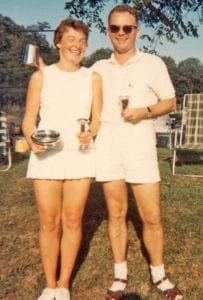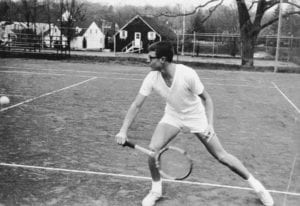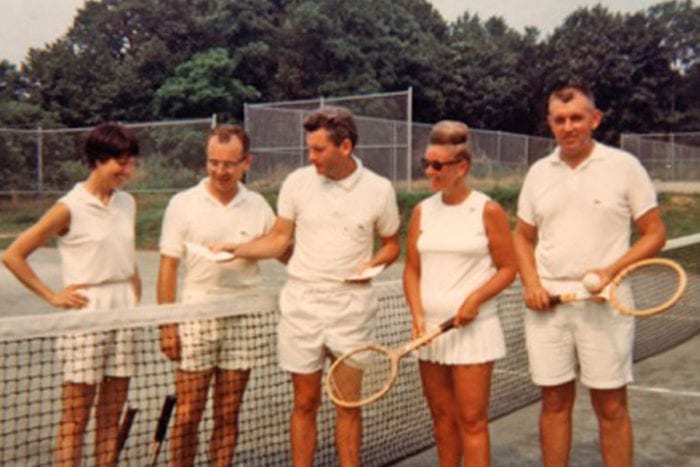By Rita J. Egan
The first tournament of the U.S. Open is scheduled for Aug. 28, but Flushing Meadows isn’t the only place in New York filled with tennis history. Since 1959, the Three Village Tennis Club on Main Street in Setauket has provided lifelong memories for its members.
Susan Falvey’s parents, Marta and Andy Kevey, were founding members of the club. She said the women would organize bake sales, fashion shows and dances to raise money, while the men helped maintain the property and the original court. In 1959, yearly dues were $15 for children, $25 for adults and $50 for families.

To her, the spot is a hidden treasure.
“The club is still very active today,” Falvey said. “It’s very simple — we don’t have a clubhouse or anything, but the courts are still in good condition.”
Falvey has fond memories playing as a child at the club and then afterwards riding bikes with friends along Main Street to go to the Jack in the Box near where the Setauket Fire Department firehouse is located today.
In an essay about the club, Andy Kevey wrote of the founding members securing a single tennis court, donated by The Setauket Neighborhood House located behind a barn.
“That old cracked asphalt court went through three metamorphosis each year: tennis court, to basketball court, to ice skating rink,” he wrote. “It had a net for tennis, two baskets for practicing shooting and 6-inch raised borders that allowed it to be flooded in the winter.”
The club hasn’t changed much through the decades, except for the number of courts and who can join. As the population in the area grew in the 1960s, the club limited its membership to residents of the Three Village Central School District.
As the club evolved, six green clay Har-Tru courts were added, and the original asphalt-based court was eventually converted to clay in the 1980s, as water doesn’t drain properly on a harder court. Once the asphalt court was converted to clay, interested players were able to join quicker. Before that, there was a five-year wait.
Wayne Mercer, who joined the club in the late 1980s and has served various positions on the board, remembers due to spacing issues that affected play, court four was moved away from court three and seven away from six. Improvements were also made so the courts would drain better.
“Courts that no one wanted to play on became very playable,” he said.
Current board member Randy Conard’s mother Marion was the first president, and one of the organization’s co-founders. He said the founding of the club was a community effort, where the original board members were trying to expand the popularity of tennis in the area.
Conard said his mother, who died in 2008 at 86, played tennis for decades at the club. His mother’s involvement, he said, “was all for the love of the community and tennis.”
Conard said members would take vacations together, going to resorts and playing tennis. Through the decades, families gathered on the club grounds for barbecues and picnics.
“It was a very tight-knit community,” he said.

Joe McDonnell moved to Setauket with his family in 1964. A preteen at the time, McDonnell said he could walk to the club by cutting through his neighbor’s backyard. He played at the Three Village Tennis Club for years and as a young man would help maintain the courts. He said his years at the club led to him teaching tennis at Harbor Hills and the Old Field Club during his time in college and graduate school, and in the late 1980s he became a member of the Three Village Tennis Club board.
“It was a club with extraordinary spirit,” McDonnell said. “Like many organizations are when they are first founded, there’s that entrepreneurial spirit.”
McDonnell said he looked up to and learned a great deal about tennis from founding member Bob Pereira, who was also his dentist.
Among the many Stony Brook University professors who were members of the club was Linwood Lee, who still teaches at the college. He said as soon as he found a home in Stony Brook he looked for a tennis club for his family to play at, and enjoyed the camaraderie at the local club.
“It’s been a wonderful place to play tennis and a wonderful place to meet friends,” Lee said.
McDonnell said the club has always helped younger players improve and employed great tennis pros. He recalled Ineke Fisher, who lived in Florida with her husband. During the summers, the couple would come to New York, and Ineke would teach at the Three Village Tennis Club while her husband taught at the Old Field Club. McDonnell said Ineke’s instructions were a mixture of technique and court etiquette.
Once a year the club holds a Wimbledon Woody social event using old wooden rackets like it used to in years past.
“It was a far more finessed game,” McDonnell said, recalling the days he used to only swing a wooden racket. “It was a slower game, but it required you to move a player around a court and not just overpower them.”
Another annual competition at the club is the mixed doubles Van Slyke Tournament. McDonnell said he still remembers Dr. Don Van Slyke, for whom the tournament was named. Van Slyke was a biochemist at Brookhaven National Laboratory, who played well into his 80s.
McDonnell moved to Maine six years ago, but said when he visits Long Island, he makes sure to stop and play at the club. He is considered an honorary member.
“This is a wonderful asset to the community,” he said. “It’s into another generation at this point, but it’s become very much established.”





